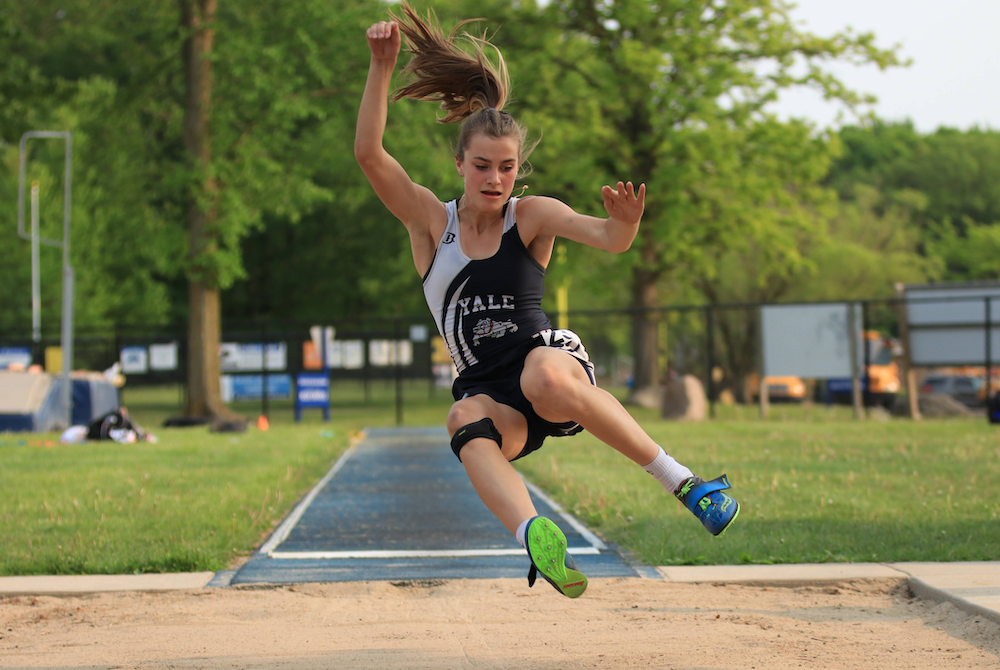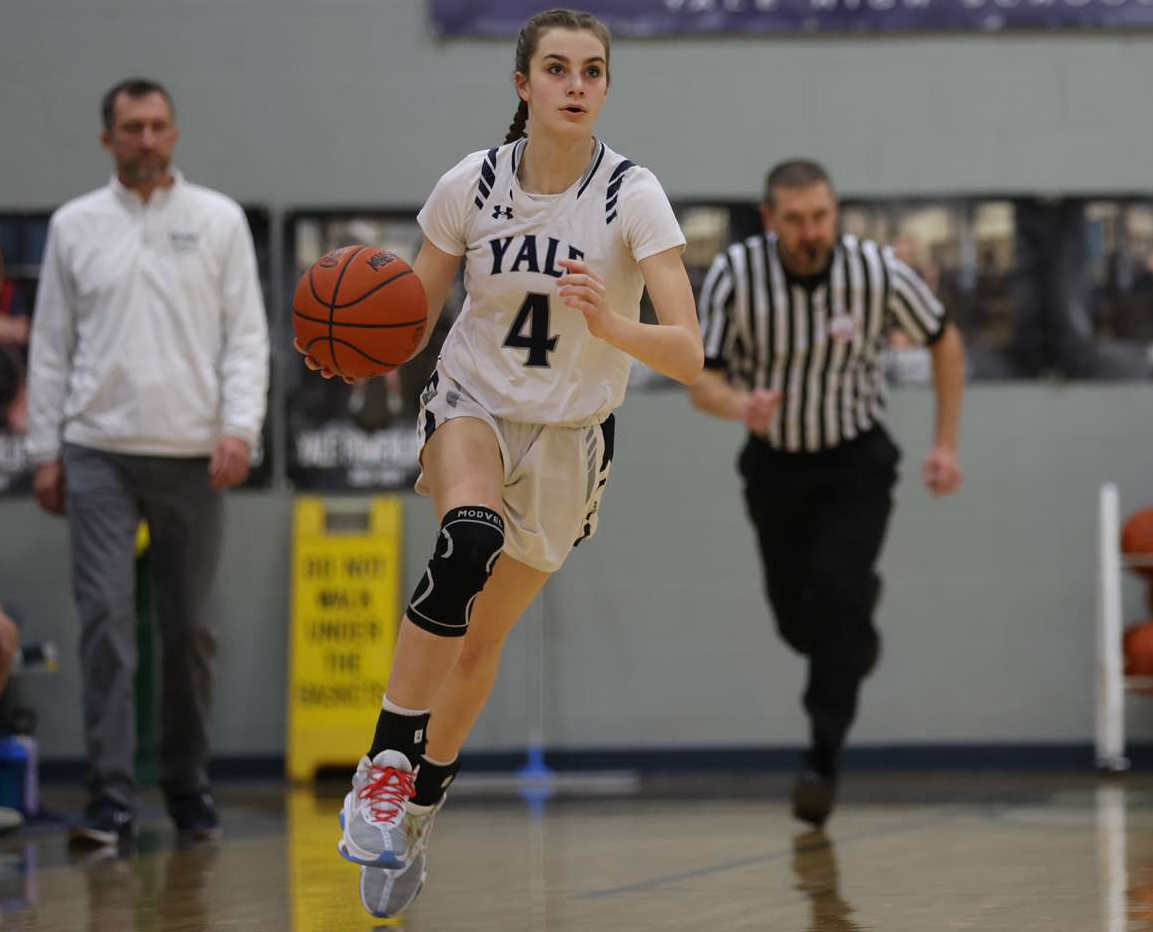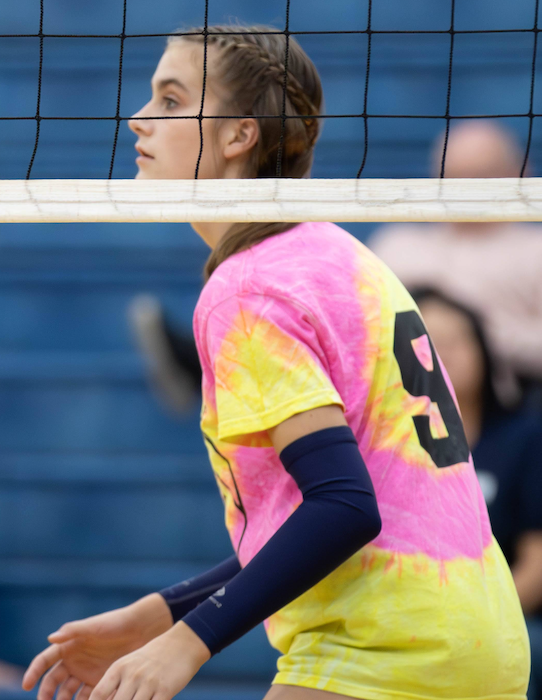
Yale's Dykstra Wasting No Time Showing Superior Multi-Sport Potential
By
Paul Costanzo
Special for MHSAA.com
March 28, 2024
Sadie Dykstra’s already long list of accomplishments from less than two years of high school – three all-state medals, multiple all-conference awards and a league MVP to name a few – may seem shocking.
 And to most, it justifiably is.
And to most, it justifiably is.
But it’s come as little surprise for those in Yale who saw her grow up and do, well, anything.
“I’ve always known that she’s kind of special,” said Yale boys track coach and Dykstra family friend Brian Bearss. “She was that kid that, when other kids would be playing and learning how to ride their bikes, here comes Sadie and she’s yelling, ‘Look at this,’ and standing on the seat riding the bike. She’s always been exceptional as far as being an athlete.”
Dykstra is entering her sophomore track & field season at Yale and has already established herself as one of the best female athletes in the state. Want to argue against that? Check out this résumé:
Volleyball: Two years varsity, second-team all-Blue Water Area Conference as a sophomore.
Basketball: Two-time first-team all-BWAC selection, BWAC all-defense and BWAC MVP as a sophomore, BCAM all-state honorable mention as a freshman, sophomore all-state honors still pending.
Track: Unbeaten in the BWAC as a freshman with four league titles (long jump, 100 hurdles, 300 hurdles and 1,600 meter relay), three all-state finishes at 2023 Lower Peninsula Division 2 Finals (fourth in long jump, fifth in 100 hurdles, sixth in 300 hurdles).
Again, just a sophomore.
“I can’t believe that I get to coach her,” Yale girls track coach Ashley Garofalo said. “She has a drive and a mindset that I can’t teach somebody. Nobody can teach you to have this. She gives every single thing that she has in every single sport. I think it does help when you’re so good at it. It makes you want to do it more.”
 Basketball gets Dykstra’s most attention and it’s the one she’d most like to play at the next level. The 5-foot-11 guard is getting interest already from Division I college programs.
Basketball gets Dykstra’s most attention and it’s the one she’d most like to play at the next level. The 5-foot-11 guard is getting interest already from Division I college programs.
But it wouldn’t be right to say her heart is with one sport or another.
“I enjoy all my sports,” Dykstra said. “I like all my teams. I have a different team for each one, and I get along with all those girls. I think each one, it flows into the next one, and helps strengthen things for my other sports. Volleyball helps my legs for basketball. In basketball, I’m getting in shape for track.”
You don’t have to look far to find where Dykstra gained her love for athletics. Her parents, Kerry and Brad, both played basketball at Calvin College. Kerry graduated as Calvin’s all-time leading scorer in 1999 and is still sixth on the all-time list. She also served as Yale volleyball coach for 10 years, just recently stepping down.
Brad was a two-sport athlete at Calvin, playing baseball as well. He also played baseball at Grand Valley State. He coached basketball at Yale from 2006-10.
“We’re a very sporty family,” Sadie Dykstra said.
So, when it came time to enter high school, there was never a thought of specializing.
“I came in with the mindset of, I’m going to play three sports each season and enjoy them, too,” Dykstra said. “I don’t want to be in them and have them be the most awful things in the universe. I came in with the mindset of enjoying all three sports.”
 While basketball is her current collegiate goal, she did say that competing in basketball and track & field would be something she would consider if given the opportunity. Bearss said Dykstra has Division I potential in track & field, adding that heptathlon could best suit her.
While basketball is her current collegiate goal, she did say that competing in basketball and track & field would be something she would consider if given the opportunity. Bearss said Dykstra has Division I potential in track & field, adding that heptathlon could best suit her.
But there are still two more years to figure that out. The next thing for Dykstra to enjoy is track, the sport in which she had the most early success. And while outdoor meets are still a couple weeks away, she’s already locked in.
“She’s just a natural leader, and I think that’s why she’s so disciplined,” Garofalo said. “(Tuesday), I was going over a workout with somebody else, and she just started her warm-ups on her own. She’s not afraid to lead 60 other kids, even though there are juniors and seniors.”
Dykstra has big goals for this spring, mostly based around performance marks. She’s eyeing the Yale school long jump record of 18 feet, 1¾ inches, which is less than an inch longer than her personal best of 18-1. She’d like to move that record closer to 19 feet.
Her 100 hurdle PR (personal record) sits at 15.59 seconds, and she’d like to knock that into the low 15s or even high 14s. For the 300 hurdles, where her PR is 47 seconds, she’d like to get down to 45.
“I have big goals, and I think I can get to them,” she said. “But that’s something for the end of the season to play out and see how that goes.”
Anybody who’s watched her wouldn’t doubt that Dykstra can reach those goals. And that list, along with those accomplishments, continues to grow.
“Last year we went to Ortonville Brandon, and we had really nice weather that day and the competition was really good – a lot of schools there,” Bearss said. “Even with all of those great athletes, you could just kind of see, people are pointing and looking, ‘There’s that girl from Yale.’ They’re taking notice. Every once in a while, you get kids that turn heads like that.”
 Paul Costanzo served as a sportswriter at The Port Huron Times Herald from 2006-15, including three years as lead sportswriter, and prior to that as sports editor at the Hillsdale Daily News from 2005-06. He can be reached at [email protected] with story ideas for Genesee, Lapeer, St. Clair, Sanilac, Huron, Tuscola, Saginaw, Bay, Arenac, Midland and Gladwin counties.
Paul Costanzo served as a sportswriter at The Port Huron Times Herald from 2006-15, including three years as lead sportswriter, and prior to that as sports editor at the Hillsdale Daily News from 2005-06. He can be reached at [email protected] with story ideas for Genesee, Lapeer, St. Clair, Sanilac, Huron, Tuscola, Saginaw, Bay, Arenac, Midland and Gladwin counties.
PHOTOS (Top) Yale’s Sadie Dykstra launches into a long jump last spring. (Middle) Dykstra brings the ball upcourt against Armada. (Below) Dykstra stands at the net during volleyball season. (Photos courtesy of the Dykstra family.)

Hastings Relays Reigns as State's Oldest Continuous Track & Field Meet
By
Steve Vedder
Special for MHSAA.com
April 10, 2024
Bob Branch remembers dabbling in other sports, but his first love was always running.
 The Hastings High School graduate admits he could never hit a baseball, football didn't especially appeal to him and basketball was just another way to spend time with friends. But for Branch, now 93, there was always track. That's the sport where his fondest and sharpest memories remain. And if you're talking track, many of his favorite memories come from participation in the state's oldest continuous track meet, the Hastings Relays.
The Hastings High School graduate admits he could never hit a baseball, football didn't especially appeal to him and basketball was just another way to spend time with friends. But for Branch, now 93, there was always track. That's the sport where his fondest and sharpest memories remain. And if you're talking track, many of his favorite memories come from participation in the state's oldest continuous track meet, the Hastings Relays.
Always held in early April, the meet dates back to 1937 – a bygone time that saw the first hostilities of World War II, gas at 20 cents a gallon and a loaf of bread selling for a dime.
And at a dusty old track surrounding the county fairgrounds in Hastings, a small relay event that included a scattering of participants from a dozen high schools was taking its first tentative steps.
Branch recalls a time when kids would run home after track practice because there were no buses, inexperienced young coaches had little actual knowledge of running fundamentals, and athletes looked at the sport as an afterthought after spending most of their high school days playing football and basketball.
 For Branch, the relays were the ideal way to ease into the track season.
For Branch, the relays were the ideal way to ease into the track season.
"I just liked to run," said Branch. "I remember I anchored a relay with my brother, and it always seemed cold when we had that meet. I remember teams would come from all over and you saw a lot of good athletes. Everybody seemed to have someone who was really good. Track wasn't very popular at that time, but I have a lot of good memories from running."
The Hastings Relays, which has changed formats and even names during its nearly nine-decade history, would traditionally kick off the track season. The meet was originally held at a makeshift quarter-mile track which surrounded the town's fairgrounds and was part of the city's annual Hastings Carnival – the track would become the midway during fair time.
The meet eventually moved to Johnson Field when the football field was dedicated in 1949 and ballooned to as many as 50 teams at its peak in 1957. For more than seven decades it was known as the Hastings Relays and then the Hastings Co-Ed relays before becoming the current Hastings Invitational, with the latest edition scheduled for Friday.
Johnson Field had a cinder track before it became an all-weather surface in the 1980s. During a time long before computers would be used to organize meet heats in mere minutes, Hastings coaches of all sports – defined as "volunteers" by the athletic department – would meet on the Friday before competition to hash out events.
People associated with the meet still recall the camaraderie built on those long Friday nights, followed by working what would often become 10-hour meets. Steve Hoke has been involved since watching his father, Jack, who coached teams at 15 of the meets beginning in 1951 and also had run in the first Hastings Relays. Steve Hoke later competed in the Relays as well during the early 1970s before becoming an assistant track coach, later the Hastings athletic director and now a volunteer worker.
"It was always a huge deal," said Hoke, who said the meet began as a pure relay event before transitioning to its current team format in the 1990s. "I remember we'd line the track the night before, and all the coaches would come to the house to organize everything. There was a brotherhood.”
 If you quiz many of the fleet of volunteers who've worked the relays over the years, each has a different memory from the meet. While Hoke describes the brotherhood and Branch the outstanding competition, others remember weather and the time a thunderstorm wiped out the line markings on the cinder track, or waking up to find three inches of snow that caused a rare cancellation of the meet. Others recall the shock of moving from the cinder to all-weather track or using the meet as an early measuring stick of what it would take to qualify for the state meet. The real old-timers remember the meet disappearing for three years during World War II.
If you quiz many of the fleet of volunteers who've worked the relays over the years, each has a different memory from the meet. While Hoke describes the brotherhood and Branch the outstanding competition, others remember weather and the time a thunderstorm wiped out the line markings on the cinder track, or waking up to find three inches of snow that caused a rare cancellation of the meet. Others recall the shock of moving from the cinder to all-weather track or using the meet as an early measuring stick of what it would take to qualify for the state meet. The real old-timers remember the meet disappearing for three years during World War II.
Hastings native and Western Michigan grad Tom Duits was the state’s second collegian to break the four-minute mile when he ran a 3:59.2 at a meet in Philadelphia in 1978. Duits, who ran in three Hastings Relays, was in line to join the U.S. Olympic team in 1980 before the United States pulled out of the games due to tension with Russia.
Duits has his own memories of the meet and the competition he faced there.
"I remember sunshine and being excited to be competing again. There were all these athletes swarming around; it was an awesome display of talent," he said. "It was always one of the best meets we'd be in. You could pretty much see the level of runners who would be at state, which made it a big deal. It was always early, but you could tell where you stood. It was great exposure."
Hastings track star Wayne Oom competed in four Hastings Relays from 1984-87. One of his sharpest memories was the difference between running on a raw cinder track versus the far more comfortable all-weather surface.
"Those cinders would grind into your skin," said Oom, part of the Hastings school record in the two-mile relay. "But I think it helped us because when we'd go to other tracks, it seemed we would run faster. I remember how competitive it was, especially in the distances. There were some great runners."
While participants have their unique memories, so do coaches. Former Saxons coach Paul Fulmer remembers 2008 when his team finished first on the boys side of the meet while his wife, Grand Haven coach Katie Kowalczyk-Fulmer, saw her girls team win the championship.
 "I knew we were one of the favorites to win because we were usually near the top of our conference and Regional," he said. "But then Katie's team was pretty good, and it was cool for them to win too."
"I knew we were one of the favorites to win because we were usually near the top of our conference and Regional," he said. "But then Katie's team was pretty good, and it was cool for them to win too."
Fulmer, who coached Hastings from 1978-81 and then 1985-2010, said at least part of the meet's popularity was derived from a unique way of scoring. Instead of individuals earning points solo, participants worked in pairs. For instance, two athletes would combine their shot put or long jump scores. New events such as the 1,500 relay and sprint medley were added.
"We had a tradition of being the state's oldest meet, and that was a big deal," Fulmer said. "And we ran a good relay; that attracted teams too. We took a lot of pride in that.
"And we'd get quite a lot of people to come to the meet. We'd set up until like 9 or 10 p.m., and then we'd have a party with all the coaches on Friday night."
While the meet has stretched 87 years, Branch said early participants and current runners have one thing in common: a drive to win. Branch ran in an era when the popularity of high school track was in its infancy. Today some of the best all-around athletes at a school are involved in the track program. The relays span the nearly nine decades in between.
"The quality of teams has gotten better and better," said Branch, the 1947 Lower Peninsula Class B Finals champ in the 220. "And this has made for a better meet. We would get guys who played football or baseball kind of drift into track, and that made the sport better. I think people began to appreciate track because we'd get teams from all over.
"We went from not really knowing what we were doing to track being a good sport. Even then, I'm not sure we appreciated what we had. We really liked the Hastings Relays and always wanted to do well there. It became popular and quite an honor to do well. Those are the kind of things I remember."
PHOTOS (Top) Racers run at the Hastings Relays, with several more awaiting their turns to compete at the longtime meet. (2) The author wrote on the 50th anniversary of the Relays for the Hastings Banner nearly 40 years ago. (3) Past athlete, coach and athletic director Steve Hoke shows some of the Relays awards from the 1930s. (4) Tom Duits was one of the state’s biggest track stars of the 1970s and ran in three Hastings Relays. (Top photo by Dan Goggins, Hoke photo provided by Steve Hoke and Duits photos provided by Tom Duits.)

